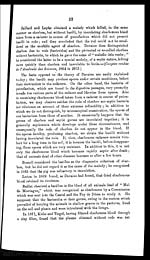Medicine - Veterinary > Civil Veterinary Departments > Civil Veterinary Department ledger series I-VI > Volume II - Anthrax
(142) Page 24
Download files
Individual page:
Thumbnail gallery: Grid view | List view

24
virulent. This proved at least that the virulence did not reside in the
liquid part.
Pasteur recognized the formation of spores in a pathogenic microbe
connected with his studies on the causes of the diseases of silk-worms,
and he found that these spores were very resistant bodies and were
capable of germination several years after their formation; but this
fact not having been verified in the case of the bacillus of Anthrax,
showed Davaine's observations to be incomplete and allowed the
discussion to continue.
P. Bert in 1876 discovered that oxygen at a pressure of several
atmospheres killed anatomical elements and living beings, whilst
it was inactive upon diastases, soluble ferments, and venoms; he
submitted the bacillus of charbon to its action; he also submitted
this virus to the action of absolute alcohol; and he observed in both
cases that inoculation gave a rapidly fatal malady, without the appear-
ance of the bacillus ; in these cases the charbonous blood had become
septic, contained spores, and produced septicæmia, the disease from
which the inoculated animals died.
Koch in 1876 first observed the multiplication of the bacillus
of charbon by the formation of spores; he cultivated it in blood plasma,
aqueous humor, in the presence of air; he placed a minute quantity of
charbonous blood in a drop of serum or aqueous humor; he saw the
bacillus lengthen and form an inextricable felting of mycelium.
He saw it not only form segments, but also very refractile
spores, very close together and regularly spaced in the interior of
the filaments. He saw the filaments become destroyed, leaving in their
place spores laid out in a line and maintained in position by a uniting
substance formed of the last vestiges of the filaments; he lastly saw
the spores isolate themselves and become free. He inoculated the spores,
causing charbon; he cultivated them in blood plasma, aqueous humor
in the presence of air; he saw them stretch, lengthen, and form rods.
He observed that they were more resistant and preserved their virulence
for a longer period than the rods.
Briefly, Koch, by cultivating the bacilli in the aqueous humor or
serum, in the presence of a moist atmosphere at a temperature of 35° to
37° C., saw the rods lengthen considerably, double, tenfold, one hundred
fold, their length, turning about and forming an inextricable network
or felting, lose in some hours their uniform structure and their trans-
parency, their contents become granular; very shortly granulations
or very refringent spores were formed more or less close together and
at regular intervals, and resembling in their form and distribution inter-
laced chaplets of pearls. These dissociate and leave in their place lines of
Set display mode to: Large image | Zoom image | Transcription
Images and transcriptions on this page, including medium image downloads, may be used under the Creative Commons Attribution 4.0 International Licence unless otherwise stated. ![]()
| India Papers > Medicine - Veterinary > Civil Veterinary Departments > Civil Veterinary Department ledger series I-VI > Anthrax > (142) Page 24 |
|---|
| Permanent URL | https://digital.nls.uk/75516198 |
|---|




